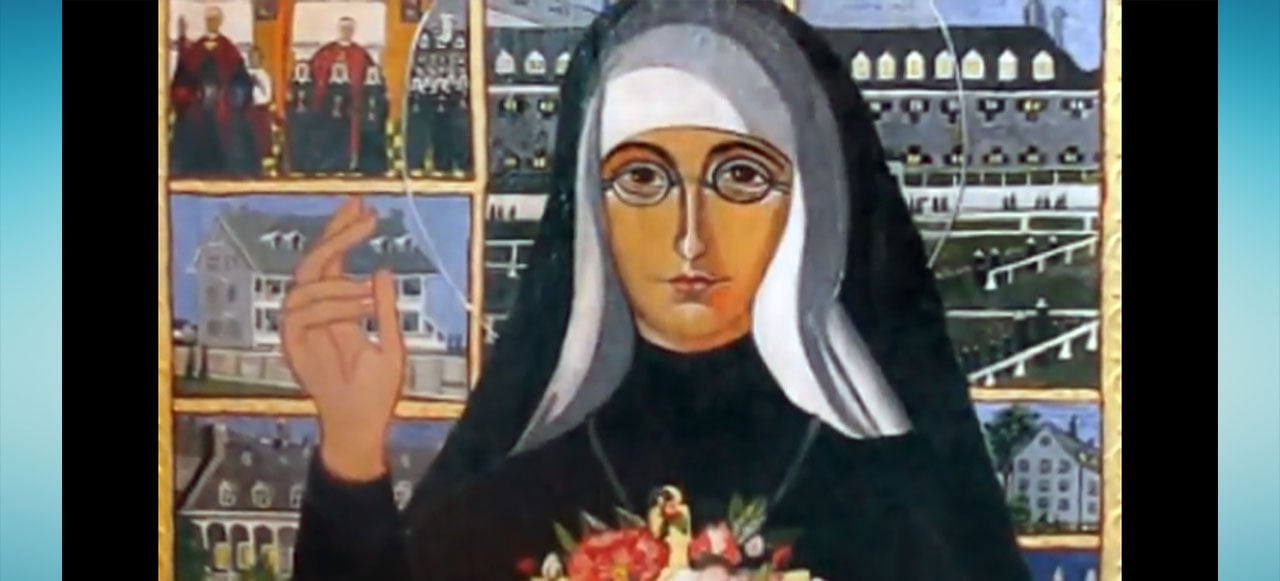Biography
Marie Rose (Eulalie Mélanie) Durocher was born in the village of Saint-Antoine-sur-Richelieu, Quebec, Canada, on October 6, 1811. She was the tenth of eleven children of a prosperous farming family.
In 1821 Eulalie Mélanie became a boarding student at a convent run by the Congregation of Notre Dame in Saint-Denis-sur-Richelieu. In 1827, she entered the boarding school of the Congregation of Notre Dame in Montreal, where she intended to enter the novitiate as her sister Séraphine had done earlier. However, her health proved too poor to allow her to complete her education there and, after two years, she returned home.
In 1830, Eulalie Mélanie´s mother died, and she assumed her mother’s role as homemaker. A year later she moved to her brother Theophile’s residence. He was already a priest, at Saint-Mathieu Parish in Belœil. There she worked as a housekeeper and secretary until 1843. During the course of this work she was made aware of the severe shortage of schools and teachers in the surrounding countryside.
In 1841, Fr. Louis-Moïse Brassard (1800-1877), parish priest of Longueuil, entered discussions with Charles-Joseph-Eugène de Mazenod, Bishop of Marseilles, France, and founder of the Missionary Oblates of Mary Immaculate, for the establishment of a mission in Quebec. The Oblates would be accompanied by a French religious congregation of sisters known as the Sœurs des Saints-Noms de Jésus et de Marie. Eulalie Mélanie Durocher learned of the proposed mission through Fr. Brassard, and volunteered to join the novitiate of the new congregation upon its arrival in Canada. However, the mission ultimately did not go ahead, and Bishop de Mazenod instead advised Ignace Bourget (1799-1885), Bishop of Montreal, whom de Mazenod had met during Bourget’s European visit of that year, to establish a similar congregation in Canada, based upon the two women who had been eager to be part of the French group.
On December 2, 1841, a group of Oblates arrived in Montreal, and in August, 1842, opened a church at Longueuil. Among the Oblates was Fr. Pierre-Antoine-Adrien Telmon, O.M.I. (1807-1878), who travelled to Belœil to conduct popular missions, where he met Eulalie Mélanie and became her spiritual director. At the beginning of 1843, the Founder received bad news from Canada. In August, he sent Father Allard there with the powers of a visitor extraordinary. Fr. Allard was subsequently replaced in this role by Father Eugène Guigues in June of 1844. In Canada, Father Allard functioned as master of novices in Longueuil from 1843 to 1849. At the same time, he served as master of novices and teacher with the Sisters of the Holy Names of Jesus and Mary. Sent to Bytown (Ottawa) in 1849, he was superior of the college in 1849-1850 and chaplain of the mother house of the Grey Nuns in 1849-1851. On January 29, 1851, he was appointed titular bishop of Samaria and first vicar apostolic of Natal in South Africa.
On October 6, 1843, Eulalie Mélanie travelled to Longueuil to witness her brother Eusèbe Durocher (*1807) profess his religious vows. He later left the Oblates. Flavien Durocher (1800-1876), another brother, also became an Oblate of Mary Immaculate. In Longueuil, Eulalie Mélanie met Bishop Bourget and Fr. Telmon. Both asked her to take a leading role in the foundation of a new religious congregation dedicated to the Christian education of youth. Eulalie Mélanie Durocher agreed to this request, and not wasting any time, on October 28, 1843, she began her postulancy at Saint-Antoine Church in Longueuil under the direction of Fr. Jean-Marie Francois Allard, O.M.I. (1806-1886).
Eulalie Mélanie brought two friends with her to start religious life: Mélodie Dufresne (1809-1881) and the schoolteacher Henriette Céré (1804-1885). On February 28, 1844, the three postulants began their novitiate, assumed the religious habit, and received their religious names. Durocher took the name Sister Marie-Rose, Dufresne became Sister Marie-Agnes and Céré became known as Sister Marie-Madeleine. The bishop of Montreal gave his diocesan approval and named the new institute “Sisters of the Holy Names of Jesus and Mary”, after the French community Durocher had hoped to join in the beginning. The Sisters adopted the Rule and Constitutions of their French namesakes, as well as a modified version of their habit. On December 8, 1844, the three women professed religious vows in the church at Longueuil. Sister Marie-Rose was named Mother Superior, mistress of novices, and depositary of the new congregation.
Immediately, the new congregation began teaching. The demand for their services was extraordinary. Between 1844 and 1849, the Sisters established four convents, in Longueuil, Belœil, Saint Lin and Saint Timothée. In 1849, they already were employing 30 teachers and educating 448 English and French speaking pupils. Originally the Sisters had planned to teach only girls, but missionary requirements eventually forced them to teach boys in some provinces.
Mother Marie-Rose, troubled throughout her life by ill health, died of “wasting syndrome” on October 6, 1849, aged 38.
